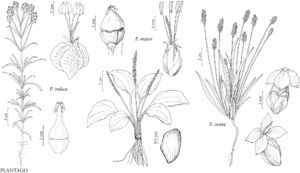Difference between revisions of "Plantago indica"
Syst. Nat., ed. 10, 2: 896. 1759, legitimacy of. name in question
FNA>Volume Importer |
imported>Volume Importer |
||
| (3 intermediate revisions by 2 users not shown) | |||
| Line 5: | Line 5: | ||
|title=Syst. Nat., ed. | |title=Syst. Nat., ed. | ||
|place=10, 2: 896. 1759, legitimacy of | |place=10, 2: 896. 1759, legitimacy of | ||
| + | |other_info_on_pub=name in question | ||
}} | }} | ||
|common_names=Sand plantain;plantain des sables | |common_names=Sand plantain;plantain des sables | ||
| Line 12: | Line 13: | ||
}}{{Treatment/ID/Special_status | }}{{Treatment/ID/Special_status | ||
|code=F | |code=F | ||
| − | |label= | + | |label=Illustrated |
}} | }} | ||
|basionyms= | |basionyms= | ||
| Line 18: | Line 19: | ||
|name=Plantago arenaria | |name=Plantago arenaria | ||
|authority=Waldstein & Kitaibel | |authority=Waldstein & Kitaibel | ||
| + | |rank=species | ||
}} {{Treatment/ID/Synonym | }} {{Treatment/ID/Synonym | ||
|name=P. psyllium | |name=P. psyllium | ||
|authority=Linnaeus | |authority=Linnaeus | ||
| + | |rank=species | ||
}} | }} | ||
|hierarchy=Plantaginaceae;Plantago;Plantago indica | |hierarchy=Plantaginaceae;Plantago;Plantago indica | ||
| Line 36: | Line 39: | ||
|elevation=0–200 m. | |elevation=0–200 m. | ||
|distribution=B.C.;Man.;Ont.;Que.;Calif.;Conn.;Del.;Ill.;Ind.;Iowa;Maine;Mass.;Mich.;Minn.;Mo.;N.H.;N.J.;N.Y.;N.C.;Ohio;Oreg.;Pa.;Vt.;Va.;Wash.;Wis.;Eurasia. | |distribution=B.C.;Man.;Ont.;Que.;Calif.;Conn.;Del.;Ill.;Ind.;Iowa;Maine;Mass.;Mich.;Minn.;Mo.;N.H.;N.J.;N.Y.;N.C.;Ohio;Oreg.;Pa.;Vt.;Va.;Wash.;Wis.;Eurasia. | ||
| + | |introduced=true | ||
|discussion=<p>While considering the proposal made by W. L. Applequist (2006) to reject <i>Plantago</i> psyllium, the Nomenclature Committee for Vascular Plants also decided that <i>P. indica</i> is a legitimate name (R. K. Brummitt 2009). A. B. Doweld and A. Shipunov (2017) published a proposal to reject <i>P. indica</i> in favor of <i>P. arenaria</i>. That proposal awaits a decision by that committee.</p> | |discussion=<p>While considering the proposal made by W. L. Applequist (2006) to reject <i>Plantago</i> psyllium, the Nomenclature Committee for Vascular Plants also decided that <i>P. indica</i> is a legitimate name (R. K. Brummitt 2009). A. B. Doweld and A. Shipunov (2017) published a proposal to reject <i>P. indica</i> in favor of <i>P. arenaria</i>. That proposal awaits a decision by that committee.</p> | ||
|tables= | |tables= | ||
| Line 45: | Line 49: | ||
-->{{#Taxon: | -->{{#Taxon: | ||
name=Plantago indica | name=Plantago indica | ||
| − | |||
|authority=Linnaeus | |authority=Linnaeus | ||
|rank=species | |rank=species | ||
| Line 60: | Line 63: | ||
|publication title=Syst. Nat., ed. | |publication title=Syst. Nat., ed. | ||
|publication year= | |publication year= | ||
| − | |special status=Introduced; | + | |special status=Introduced;Illustrated |
| − | |source xml=https:// | + | |source xml=https://bitbucket.org/aafc-mbb/fna-data-curation/src/2e0870ddd59836b60bcf96646a41e87ea5a5943a/coarse_grained_fna_xml/V17/V17_694.xml |
|genus=Plantago | |genus=Plantago | ||
|species=Plantago indica | |species=Plantago indica | ||
Latest revision as of 20:36, 5 November 2020
Annuals; roots taproots, slender. Stems 100–350 mm, freely branched. Leaves cauline, opposite, 60–80 × 1–3 mm; blade linear to linear-lanceolate, margins entire or toothed, veins conspicuous or not, surfaces hairy. Scapes 100–650 mm, hairy. Spikes greenish or brownish, (50–)150–250 mm, densely flowered, eglandular; bracts proximal strongly differing from distal, ovate, 2–5(–7) mm, length 1–1.5 times sepals, proximal bracts: apex acute. Flowers: sepals 2–3 mm; corolla radially symmetric, lobes reflexed, 2–4 mm, base obtuse; stamens 4. Seeds 2, 2–2.5 mm. 2n = 12.
Phenology: Flowering late summer–fall.
Habitat: Roadsides, railroads, sandy shorelines.
Elevation: 0–200 m.
Distribution
Introduced; B.C., Man., Ont., Que., Calif., Conn., Del., Ill., Ind., Iowa, Maine, Mass., Mich., Minn., Mo., N.H., N.J., N.Y., N.C., Ohio, Oreg., Pa., Vt., Va., Wash., Wis., Eurasia.
Discussion
While considering the proposal made by W. L. Applequist (2006) to reject Plantago psyllium, the Nomenclature Committee for Vascular Plants also decided that P. indica is a legitimate name (R. K. Brummitt 2009). A. B. Doweld and A. Shipunov (2017) published a proposal to reject P. indica in favor of P. arenaria. That proposal awaits a decision by that committee.
Selected References
None.
